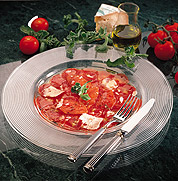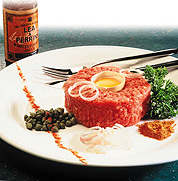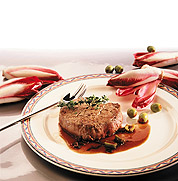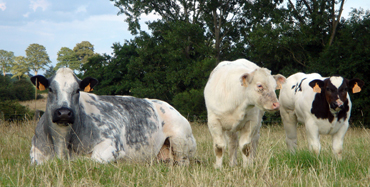Stature
The weight of an adult bull ranges from between 1.100 and 1.250 kg, for a height at the withers of about 1m45 to 1m50. Indeed, it is by no means rare to see animals heavier than 1.300 kg.
The average weight of an adult cow at the beginning of pregnancy is 700 - 750 kg, with a height at withers of 132 to 134 cm. Cows can reach a weight of 850 to 900 kg and can exceed 140 cm.
> Table of weights and heights
Coat
Apart from the «pie» character (recessive vis-à-vis «all colored») present in most colored animals, three color types are typical for the breed: all white, blue (pie-blue) and black (pie-black). These 3 phenotypes correspond to the isolation of a gene pair inherited from the Shorthorns. The blue (equivalent to the roan in Shorthorns) is the intermediate, heterozygote phenotype.
Among these 3 phenotypes, the black one is the least popular in Belgium.
Nevertheless, in Scotland for instance, the black Belgian Blue bulls are popular for crossing on Angus cows.
Zootechnical qualities
• Age at 1st calving :
Female Belgian Blues are precocious and reach puberty earlier than the females of other beef breeds. The average age at 1st calving is 29-30 months. However, in many herds, the heifers calve at 24 months. They are therefore fed intensively until their first calving.
• Gestation and twin births :
The Belgian Blue Breed belongs to the group of breeds with relatively short gestation periods. For the male fetus, it is 282.6 days and for the female fetus, 281.6 days.
Frequency of twins is 2.3% on average.
• Birth weight :
The birth weight of male calves is on average 47 kg. Female calves weight 44 kg at birth.
• Calving interval :
The average interval is 14 months; for 75% of cows, it ranges from between 11 and 15 months.
• AI non-return rate :
In Belgium, approximately 50% of the cows are bred through artificial insemination. The non return rate at 58 days is 69.7%
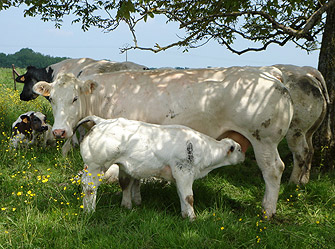
Calving issues :
In purebred animals, the calves’ conformation (dramatically increasing the butcher value) leads to more difficult calvings. This is why in Belgium, the planned accompaniment of the birth of the Belgian White-Blue calf by the farm veterinarian is a general practice. On the basis of his expertise, and with a concern for the well-being of the mother and the calf, the veterinarian can decide to carry out a caesarean section. This practice is not currently questioned within our selection programme. However, we do carry out a very detailed monitoring of the breed. For example, the conformation and weight of the calves at birth is monitored fairly closely in the selection programme, which is demonstrated by the outstanding characteristics of the breed for terminal crossbreeding, particularly with regard to calving ease. In crossbreeding on Holstein cows, the percentage of Caesarean sections is only around 4% and even less for some bulls. Comparative trials carried out in various European countries on Holstein, Hereford, Angus cows,... have shown that the proportion of assisted calvings is of the same order of magnitude as that observed with other continental meat breeds (Limousin, Blonde d'Aquitaine...).
Daily Gain - Feed efficiency
The Average Daily Gain (ADG) of bulls from 7 to 13 months measured at the Bovine Selection Station (bulls calves intended for breeding) reaches 1.6 kg/day.
In fattening, the ADG of bulls rises to 1.2 kg.
The feed conversion rate (kg of feed by kg growth) is systematically better with the Belgian Blue. This cattle consumes less and transforms more efficiently.
The higher rate is mostly due to a higher protein weight gain and weak fat gain. The feed conversion rate is in the 5 kg range from 7 to 13 months. Given its low propensity to deposit fats, the «meaty» animals can be raised and «fattened» on a diet rich in energy which leads to higher weights without excess fats. The traditional formula is to produce 18 to 19 month old bulls weighing around 650 kg.
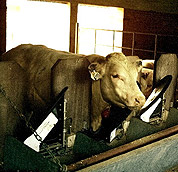
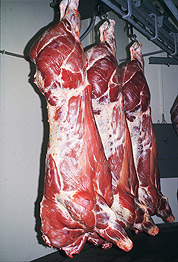
Killing-out percentage - Carcass composition
The average killing out percentage of the Belgian Blue animals reaches at least 70%. With a carcass yield of 82% or more, these animals provide, for the same liveweight of 600kg for example, 100 kg more meat than animals with a 60% killing-out.
In Belgium, 70% of young cattle fall in the S and E categories (of the European classification system), while in the other E.U. countries, the majority belongs to the U, R and O classes. The Belgian Blue breed produces a lot of meat while causing very little waste.
In the hands of skilled Belgian butchers muscles that typically give 2nd grade cuts are reclassified as 1st grade cuts which increases the yield of consumer-prized fast-cooking pieces by 35%.
Meat quality
The Belgian Blue breed has been selected by the breeders to satisfy the consumer’s expectations. Statistics show that in Belgium each person consumes on average 100 kg meat per year, of which 20 kg of bovine meat. The Belgian Blue contributes 75% of the red meat production.
The breed is not only characterized by the quantity of produced meat but also by its quality.
Its high nutritional value is determined by 4 main elements : the meat is rich in high biological quality protein, in vitamins B3 and B12, in iron and zinc, both being on an easily assimilated form.
The Belgian Blue meat is recommended by doctors and dieticians. Indeed, it contains less cholesterol (+/- 45 mg/100g) than skinless chicken meat (+/- 62 mg/100g).
Moreover the BB meat contains on average 5% fat, that is to say 2 to 3 times less than the meat produced by other breeds. Its lipid composition is characterized by a good fatty acids balance; fat of such quality is not unhealthy.
The meat is very tender because of the finer fibers and lower percentage of tough connective tissue.
Belgian Blue meats require about 1/3 less cooking time than standard beef.
Belgian Blues offer consumers exactly what they want: naturally lean, tender and tasty meat, produced with respect for the animal wellbeing and the food safety.
